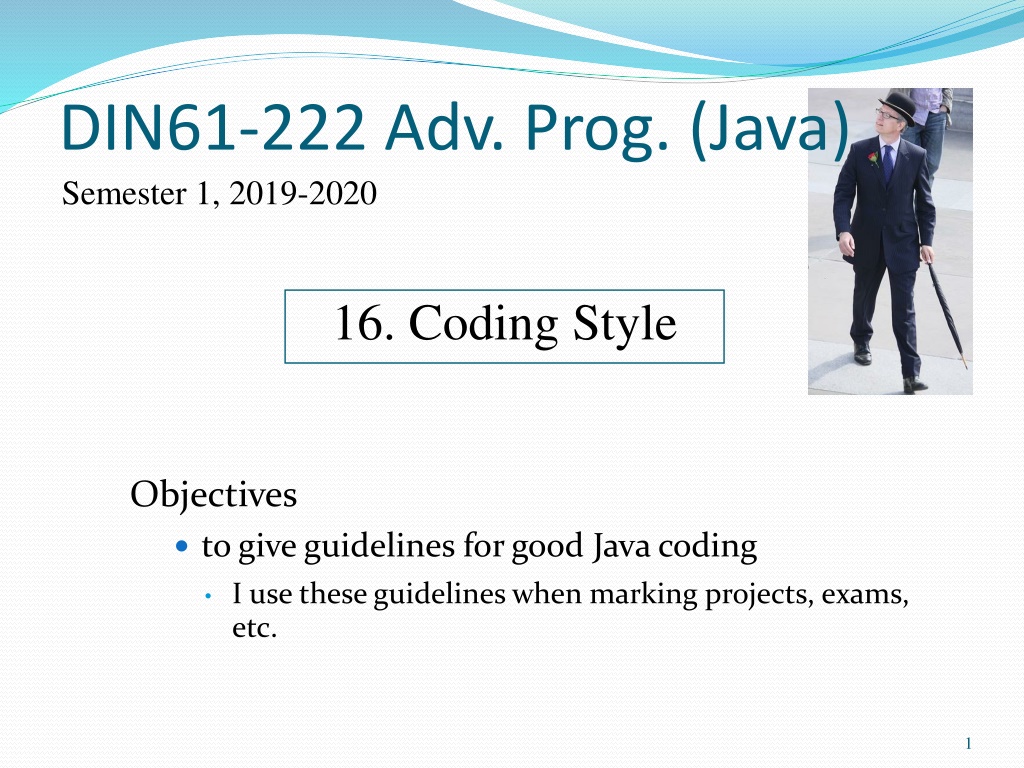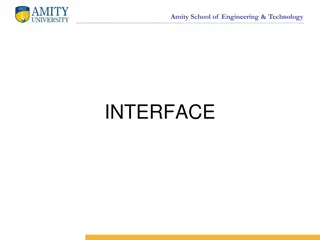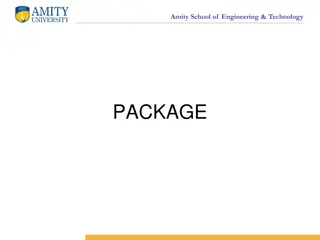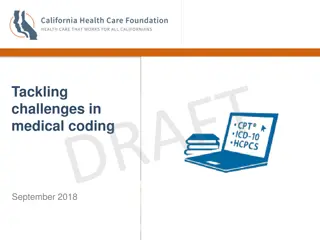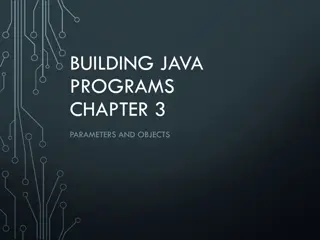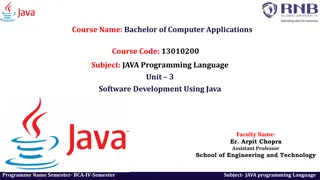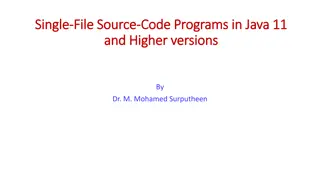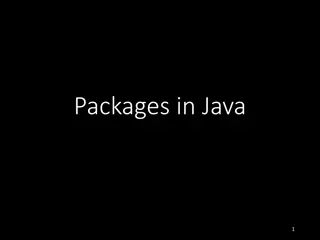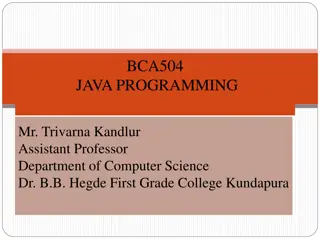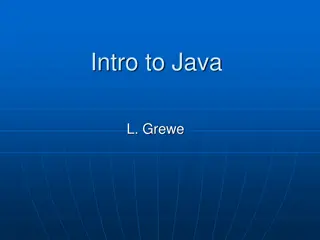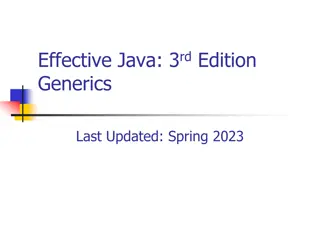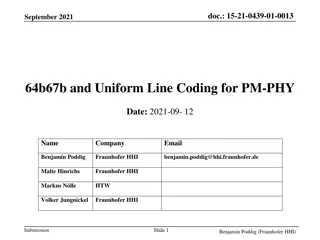Coding Style Guidelines for Java Programming
In this document, you will find comprehensive guidelines for good Java coding practices. Covering important aspects such as naming conventions for classes and objects, handling class data, using static for constants, initializing variables, and minimizing global variables. Following these guidelines will help ensure consistency and readability in your Java projects.
Download Presentation

Please find below an Image/Link to download the presentation.
The content on the website is provided AS IS for your information and personal use only. It may not be sold, licensed, or shared on other websites without obtaining consent from the author.If you encounter any issues during the download, it is possible that the publisher has removed the file from their server.
You are allowed to download the files provided on this website for personal or commercial use, subject to the condition that they are used lawfully. All files are the property of their respective owners.
The content on the website is provided AS IS for your information and personal use only. It may not be sold, licensed, or shared on other websites without obtaining consent from the author.
E N D
Presentation Transcript
DIN61-222 Adv. Prog. (Java) Semester 1, 2019-2020 16. Coding Style Objectives to give guidelines for good Java coding I use these guidelines when marking projects, exams, etc. 1
Overview 1. Class-related Guidelines 2. Method-related Guidelines 3. Comment-related Guidelines 4. Layout-related Guidelines 5. More Information 2
1. Class-related Guidelines 1.1. Class Names 1.2. Object Names 1.3. Class Data 1.4. Static for Constants 1.5. Initializing Variables 1.6. Few Global Variables 1.7. Get and Set 1.8. Change Date Locally 1.9. Classes in Files 3
1.1. Class Names A class name should be a noun the noun is often a "type-of-thing" word starts with an uppercase letter e.g. Plane, Car, Database long names may use several words e.g. JumboJet, Toyota, StudentDb each word starts with an uppercase letter 4
1.2. Object Names An object name should be a noun the noun is often the class word and a number e.g. plane1 car2, database5 but try to use names with more meaning e.g. andrewDb, coeCar starts with a lowercase letter 5
1.3. Class Data Always define data as private e.g. private int x; Avoid the keywords public, protected Always include a visibility keyword e.g.int x; // bad: unclear 6
1.4. Static for Constants Only use staticto declare constants: private static final int MAXLEN = 120; always write static final always write the constant name in all uppercase (Almost) never use staticwith methods (except for main()) 7
1.5. Initializing Variables Global objects and variables should be initialised inside a method (often the constructor): private int counter; // global public Matrix() { counter =0; } It may be okay to initialise simple global variables (e.g. ints, doubles) globally: private int counter =0; // global 8
1.6. Few Global Variables Keep the number of global variables in a class to a minimum. BadCode: private int x; // global in class public void calc() { x =0; bar(5); System.out.println(x); } private void bar(int y) { x = x + y; } continued9
The code is bad because a person who looks at a class will need to check every line of code to find out where x is used. The use of globals often means that a student is not sure how to change variables or objects inside Java methods continued10
the global x has gone Good Code: public void calcX() { int x =0; x = addX(x,5); // x gets new value System.out.println( x= + x); } private int addX(int x, int y) { return x+y; } x in addX() is a copy of the x in calcX() continued 11
The code is better since x is local to the method that uses it, and is passed as a parameter to the other method Note how x is updated by using return the following code will not change x in calcX(): private void addX(int x, int y) { x = x+y; } continued12
Good code with objects: public void calcMatrix() { Matrix m1 = new Matrix(); processMatrix(m1); m1.print(); } objects are passed using call-by-reference, so do not need to be returned private void processMatrix(Matrix m) { // change m (really m1) } 13
1.7. Get and Set Private data which will be accessible outside an object should be given setand getmethods public class BankAccount { private double balance; public double getBalance() { return balance; } public void setBalance(double b) { balance = b; } : } continued14
The method names must be set<Variable> and get<Variable>. Only include a setmethod if the variable needs to be changed. 15
1.8. Change Data Locally Methods that change data should be in the class where the data is declared. Badcode: public static void main(String args[]) { BankAccount myacc = new BankAccount(); double bal = myacc.getBalance(); bal = bal * 1.15; // calculate interest myacc.setBalance(bal); } balchange is done in main() continued 16
Good code (in BankAccount): public void applyInterest(double interest) { bal = bal * interest; } in main(): BankAccount myacc = new BankAccount(); myacc.applyInterest(1.15); balchange done in the BankAccount object 17
1.9. Classes in Files If a class is longer than 2 pages of code then it should be saved in its own Java text file. There should not be more than 3 classes in a single Java text file. Having multiple files makes it easier to find code, and (re-)compilation is quicker. continued18
I use Windows Grep to search for text inside multiple files (and directories) free from http://www.wingrep.com 19
2. Method-related Guidelines 2.1. Method Names 2.2. Method Visibility 2.3. Method Length 2.4. Keep Anonymous Classes Small 20
2.1. Method Names A method name should have the form verbNoun( ) e.g. makeGraph(), printFile() Comments should not echo the method name: private void makeGraph() // make the graph { ... } useless since it adds no new information 21
2.2. Method Visibility Methods should be privateunless they will be called from outside the object. In basic Java programming, you will not need to use the protectedkeyword. 22
2.3. Method Length No method should be longer than 1 page of print-out e.g. large constructor methods are bad No method should be smaller than 5 lines except for main() which should be as small as possible 23
2.4. Keep Anonymous Classes Small An anonymous class inside a method should be less than 10 lines long. A separate handler class is better style for large size listener code. 24
3. Comment-related Guidelines 3.1. Project Details 3.2. Project Overview 3.3. Class/Method Comments 3.4. Other People s Code 3.5. Line Comments 3.6. Comment Style 25
3.1. Project Details The top-level class is your program must start with project details: subject number, subject name project title student name, student number, student e-mail date when project finished (submitted) continued26
3.2. Project Overview The top-level class is your program must include an overview of the project. About 1/2 - 1 page of text, made up of: 3-5 lines explaining the project; lines explaining how to compile and run the program; lines explaining program input and output 27
3.3. Class/Method Comments Each class must start with 5-15 lines explaining what it does. Each complex method should have 1-5 lines of comments at the beginning, saying what it does. 28
3.4. Other Peoples Code If you use (or modify) someone s code, then you must include comments giving: the name of the original class/method; the author s name; where the class/method is from (e.g. a URL); when you obtained (downloaded) the class/method; how you modified the class/method 29
3.5. Line Comments Complex pieces of code inside a method should be commented with// // calculate the Von Krotsberg value double vk = x * (y-1) * (y-1); Put the comment on a line above the code, or following the code on the same line. 30
3.6. Comment Style Do not surround a comment with lots of rubbish. e.g. /****************************** ******++++++++++++++++++******* ****** method getBalance() ** *******************************/ public int getBalance() { return balance; ) most (all) of this can be deleted 31
4. Layout-related Guidelines 4.1. Avoid the Tab Key 4.2. Use Good Code Layout 4.3. Wrap-around Lines 4.4. Use a Java code Formatter (perhaps) 4.5. Don t Waste Trees 4.6. Print-out Style 32
4.1. Avoid the Tab Key Do not tab to indent code: private int foo() { if (x < 2) { } the code disappears off the screen and print-out if (y > 4) { if ( z != 5) { : BAD Tab key pressed x = 1; continued 33
Instead, use two spaces for a "tab": int foo() { if (x < 2) { if (y > 4) { if ( z != 5) { x = 1; : } pressed space key GOOD continued 34
4.2. Use Good Code Layout Badlayout example: if (x<2) x++; else {y++; x--} Look in text books for examples of good layout (or in my code examples). 35
4.3. Wrap-around Lines A wrap-around line is a very long line of code that goes off the right edge of the screen and starts again on the next line. They are BAD. These lines are hard to read, and when the code is printed, the wrap-around part may not appear. Reformat the line to be several shorter lines. 36
4.4. Use a Java code Formatter (perhaps) I sometimes use a source code formatter called jacobe to help me format Java code. A free version for Windows is available at: http://www.tiobe.com/jacobe.htm But, changing its default output requires the editing of a large configuration file. continued37
4.5. Don't Waste Trees Print two pages of code onto a single sheet of A4 this will half the amount of paper you use FinePrint is a printer driver that will do this for most printers get it from http://www.fineprint.com continued39
4.6. Print-out Style In Windows, programs should be types using 10 point Courier New. e.g.: hello from Andrew Print in pure black and white (i.e. no grey scales) colour is acceptable, but not required continued41
If your text editor allows it, include the date, time, and page numbers in the print-out. I use the Notepad++ text editor, free from http://notepad-plus-plus.org/ has a Thai language pack continued42
Do not write on the print-out using a pen or pencil. Do not put the print-out in a plastic envelope and/or binder. Do staple the pages of the print-out together at the top-left hand corner. 44
5. More Information A great book on coding style (for any language, not just Java): Code Complete Steve McConnell Microsoft Press, 2nd ed., 2004 http://cc2e.com/ 45
